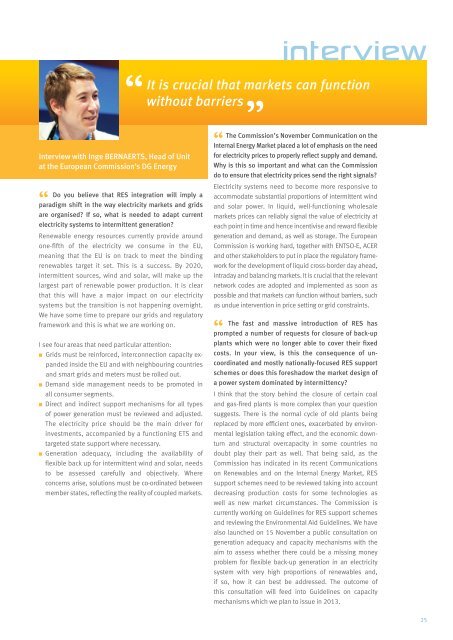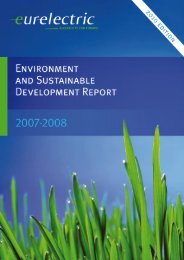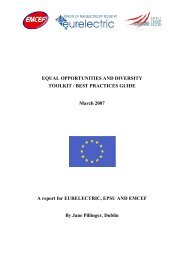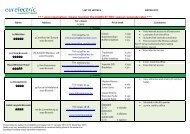Activity Report 2012 - Eurelectric
Activity Report 2012 - Eurelectric
Activity Report 2012 - Eurelectric
Create successful ePaper yourself
Turn your PDF publications into a flip-book with our unique Google optimized e-Paper software.
Interview with Inge BERnAERTS, Head of Unit<br />
at the European commission’s Dg Energy<br />
Do you believe that rEs integration will imply a<br />
paradigm shift in the way electricity markets and grids<br />
are organised? If so, what is needed to adapt current<br />
electricity systems to intermittent generation?<br />
Renewable energy resources currently provide around<br />
one-fifth of the electricity we consume in the EU,<br />
meaning that the EU is on track to meet the binding<br />
renewables target it set. This is a success. By 2020,<br />
intermittent sources, wind and solar, will make up the<br />
largest part of renewable power production. It is clear<br />
that this will have a major impact on our electricity<br />
systems but the transition is not happening overnight.<br />
We have some time to prepare our grids and regulatory<br />
framework and this is what we are working on.<br />
I see four areas that need particular attention:<br />
Grids must be reinforced, interconnection capacity expanded<br />
inside the EU and with neighbouring countries<br />
and smart grids and meters must be rolled out.<br />
Demand side management needs to be promoted in<br />
all consumer segments.<br />
Direct and indirect support mechanisms for all types<br />
of power generation must be reviewed and adjusted.<br />
The electricity price should be the main driver for<br />
investments, accompanied by a functioning ETS and<br />
targeted state support where necessary.<br />
Generation adequacy, including the availability of<br />
flexible back up for intermittent wind and solar, needs<br />
to be assessed carefully and objectively. Where<br />
concerns arise, solutions must be co-ordinated between<br />
member states, reflecting the reality of coupled markets.<br />
interview<br />
It is crucial that markets can function<br />
without barriers<br />
The Commission’s november Communication on the<br />
Internal Energy Market placed a lot of emphasis on the need<br />
for electricity prices to properly reflect supply and demand.<br />
Why is this so important and what can the Commission<br />
do to ensure that electricity prices send the right signals?<br />
Electricity systems need to become more responsive to<br />
accommodate substantial proportions of intermittent wind<br />
and solar power. In liquid, well-functioning wholesale<br />
markets prices can reliably signal the value of electricity at<br />
each point in time and hence incentivise and reward flexible<br />
generation and demand, as well as storage. The European<br />
Commission is working hard, together with EnTSO-E, ACER<br />
and other stakeholders to put in place the regulatory framework<br />
for the development of liquid cross-border day ahead,<br />
intraday and balancing markets. It is crucial that the relevant<br />
network codes are adopted and implemented as soon as<br />
possible and that markets can function without barriers, such<br />
as undue intervention in price setting or grid constraints.<br />
The fast and massive introduction of RES has<br />
prompted a number of requests for closure of back-up<br />
plants which were no longer able to cover their fixed<br />
costs. In your view, is this the consequence of uncoordinated<br />
and mostly nationally-focused RES support<br />
schemes or does this foreshadow the market design of<br />
a power system dominated by intermittency?<br />
I think that the story behind the closure of certain coal<br />
and gas-fired plants is more complex than your question<br />
suggests. There is the normal cycle of old plants being<br />
replaced by more efficient ones, exacerbated by environmental<br />
legislation taking effect, and the economic downturn<br />
and structural overcapacity in some countries no<br />
doubt play their part as well. That being said, as the<br />
Commission has indicated in its recent Communications<br />
on Renewables and on the Internal Energy Market, RES<br />
support schemes need to be reviewed taking into account<br />
decreasing production costs for some technologies as<br />
well as new market circumstances. The Commission is<br />
currently working on Guidelines for RES support schemes<br />
and reviewing the Environmental Aid Guidelines. We have<br />
also launched on 15 november a public consultation on<br />
generation adequacy and capacity mechanisms with the<br />
aim to assess whether there could be a missing money<br />
problem for flexible back-up generation in an electricity<br />
system with very high proportions of renewables and,<br />
if so, how it can best be addressed. The outcome of<br />
this consultation will feed into Guidelines on capacity<br />
mechanisms which we plan to issue in 2013.<br />
25

















